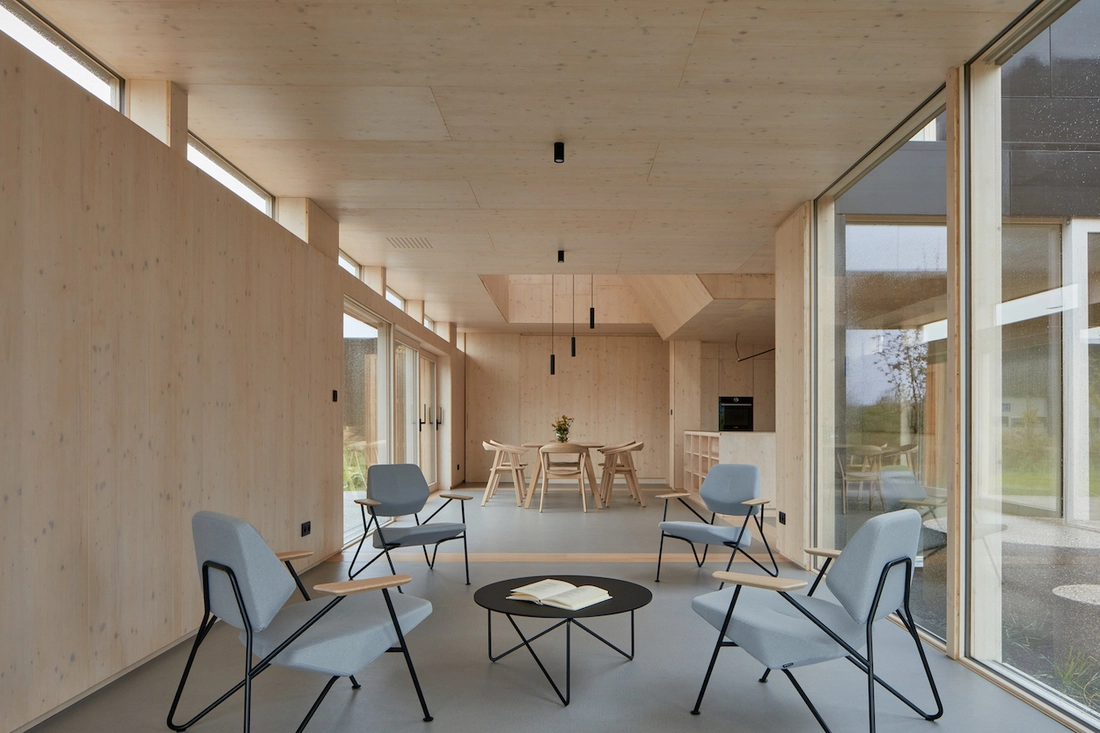Specify and procure FF&E and OS&E at scale with Fohlio today. Empower teams to move faster and improve their operational workflow with specification, prototyping, procurement, collaboration, and analytics tools.
What happens when the warmth and intentionality of hospitality design enter the sterile hallways of healthcare facilities? A revolution. One that isn't just aesthetic—it's emotional, functional, and profoundly human.
At the recent Healthcare Meets Hospitality session during the May 6 trade show, two recurring themes emerged: design is becoming more central in healthcare environments, and procurement is evolving from a bottleneck to a strategic partner. Here's what your peers are seeing—and how you can stay ahead.

Photo credit: Halkin/Mason Photography, LLC – AIA Healthcare Design Award 2024
1. In-House Teams Are Taking the Lead
Traditionally, large design and construction firms have steered healthcare projects.
But increasingly, healthcare institutions are building in-house teams to manage everything from construction and material selection to FF&E specifications.
Why? More control. More alignment. More accountability. But also—more complexity.
In-house teams are realizing that the true cost of healthcare projects isn’t just in material choices—it’s in long-term operations and staff retention. Turnover, for example, can quietly bleed budgets dry for years, long after the ribbon-cutting. Good design, smart procurement, and well-integrated tools are key to fighting that trend.
2. The Bar Is Rising: Design Expectations Are Not Optional
No more drab waiting rooms or cold corridors. Today’s healthcare environments are expected to feel as intentional and welcoming as boutique hotels.
Patients and their families expect comfort. Providers need environments that support their emotional resilience. And institutions are recognizing that design is not just about looks—it’s about outcomes.
Reducing patient stress? Improving staff retention? Enhancing healing environments? Good design does all of that—and more.
Color psychology, for example, has a measurable impact on emotional wellbeing in healthcare settings. From calming blues in recovery spaces to energizing greens in therapy rooms, designers are using color not just decoratively, but therapeutically.
3. Wellness: The Common Language Between Healthcare and Hospitality
One of the most exciting trends is how the concept of wellness is becoming the connective tissue between two seemingly different design disciplines.

Designed by ARCHEKTA and Ark-shelter in collaboration with neuroscientist Menno Cramer, this cancer care center in Knokke-Heist, Belgium, prioritizes 'brain healthy' environments rooted in neuroscience and empathy. The project was commissioned by AZ-Zeno Hospital, with inspiration drawn from the Maggie’s Centre model.
Photo © BoysPlayNice. Source
Wellness is not a buzzword. It's the future of healthcare environments:
These elements are no longer “nice-to-haves.” They’re essential components in modern design strategies aimed at nurturing mental and physical wellness. This blog dives deeper into how wellness is reshaping healthcare architecture, from layout to furniture selection.
4. Sterile Is Out. Human Is In.
There’s a long-standing stigma around healthcare environments: that they’re impersonal, sterile, and anxiety-inducing.
Designers are actively rewriting that script. But it’s not without tension. Functionality still rules, and infection control, durability, and compliance can’t be sacrificed.
The challenge? Marrying warmth and utility.
Fortunately, these two goals aren’t mutually exclusive. Three infection control design strategies show that you can create warm, inviting spaces without compromising on safety—especially when it comes to material selection, spatial flow, and fixture planning.

To illustrate how even emergency department spaces can adopt hospitality principles, CannonDesign’s work for the UC Health Emergency Department lobby in Cincinnati is a standout example. The design team specified lighting shaped like paper lanterns—symbols of joy and longevity—paired with warm neutrals in the furniture and artwork to create a soothing, human-centric environment. [Source: CannonDesign project via HealthcareDesignMagazine.com]
5. Designing for Providers, Too
It’s not just about the patient journey.
Design must now consider healthcare providers—the nurses, doctors, and staff who face constant emotional strain. Break rooms, respite spaces, and even workstations must be designed with intention.
This is especially true in long-term care environments and high-risk facilities. The differences between designing for nursing homes vs. outbreak facilities highlight how critical it is to balance infection control with warmth and livability.

A thoughtfully designed practice break room featuring home-style wooden cabinets and comfortable seating, creating a relaxing environment distinct from clinical spaces.
Image courtesy of Elite Fitout. Source
6. Procurement: The Unsung Strategic Partner
In the Meet the Purchasers session, one thing was clear: Procurement professionals wear many hats.
They’re part designer, part project manager, part vendor wrangler—and they’re under constant pressure to deliver on time and on budget.
Too often, procurement and design sit on opposite sides of the table. But that’s changing. Better communication leads to better projects.
It also leads to more future-ready spaces. This guide to FF&E and equipment strategy walks through how procurement teams can improve flexibility, adaptability, and scalability in long-term facility planning.
7. What Procurement Really Wants From Vendors
Here’s what stood out:
-
Clarity over cleverness. Fancy presentations won’t save you if your pricing is murky.
-
Partnerships over transactions. Long-term alignment trumps one-time wins.
-
Transparency and fairness. Don’t hide terms. Don't ghost. Do follow through.
This is where technology can help.
Tools like Fohlio’s RFQ module (coming soon) will enable:
-
Aligned pricing expectations
-
More transparent communication with vendors
-
A shared platform between procurement and design teams
8. The Real Opportunity for Innovators
Whether you’re a designer, project manager, or procurement lead, the path forward is shared:
-
Design and procurement need to work hand in hand.
-
Budgets should enable creativity—not block it.
-
Wellness is the new benchmark for design quality.
And most importantly, the spaces we create should feel human.
Final Thoughts
Healthcare is no longer exempt from design trends—it’s leading them. And with the tools to bridge communication gaps, standardize workflows, and support long-term vendor relationships, the healthcare sector has a golden opportunity: to raise the standard for healing spaces everywhere.
At Fohlio, we’re excited to help build that future—with you.
Specify and procure FF&E and OS&E at scale with Fohlio today. Empower teams to move faster and improve their operational workflow with specification, prototyping, procurement, collaboration, and analytics tools.